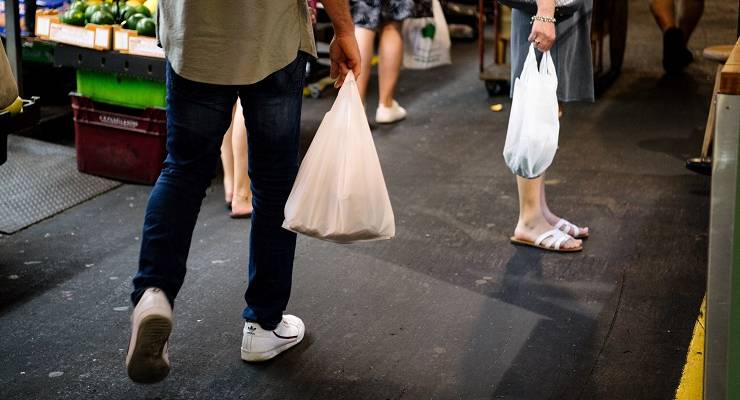
The keep cup has fallen. Once-fashionable reusable shopping bags are now something of a faux pas. And on the streets, disposable takeaway containers spill out of overflowing yellow bins.
COVID-19 has caused plastic to made a comeback in a big way across the world. Health concerns have fuelled demand for single-use plastic, and negative oil prices mean producing plastic is cheaper than ever before.
Crikey takes a look at the resurgence of the once-dreaded product and asks whether our switch back to plastic could be permanent.
The plastic comeback
Bans of plastic bags and single-use bottles have been suspended across the US and India. The UK has reversed guidelines limiting the production of plastic. In Australia, there’s been a surge in home-delivered groceries and packaged takeaway meals, while the World Health Organisation has called for 40% increase in the manufacturing of disposable personal protective equipment.
Paul Harvey, a research scientist at Environmental Science Solutions, says there’s been a shift in people’s attitudes to plastic.
“People’s attention is moving away from environmental matters to health-conscious,” he told Crikey.
From travel-sized bottles of hand sanitiser to facemasks which contain plastic vinyl composites, Harvey said the public is becoming accustomed to single-use plastics.
“In the short term, I suspect there’ll be an increase in the demand from products made from plastic as we go back to normal. People will feel more comfortable having things in a perceived cleaner environment than taking their own shopping bags or reusable cups,” he said.
In the long term, there’s a concern these habits could stick. “It may become a mindset and a way of life. People are going to become reliant on single-use plastics as they previously were.”
Oil!
Plastic is incredibly cheap to make, which is why it’s so popular among manufacturers, Dr Stuart Thickett, a polymer chemist and senior lecturer at the University of Tasmania told Crikey.
“Plastic is manufactured from crude oil. While most crude oil is used to make fuel, some of it is refined and processed to extract the material needed to make polymers — in other words, plastic,” he said.
As the price of oil continues to plummet into negative numbers this week, so too does the price of manufacturing plastic.
“Making commodity plastics is pretty cheap, especially compared to other ways of making plastics from biodegradable materials to renewables,” he said. “People are going to jump on the fact crude oil prices are really low.”
Low oil prices make virgin plastic cheaper than recycled plastic, meaning there’s no incentive for recycling systems to operate.
Meanwhile, online department store purchases are up 473%, while fashion purchases are up 203%. Many textiles, including polyester, contain plastic.
“There’s a big push to do away with reusables and a pushback toward single-use stuff … but plastics carry coronavirus on their surface as well, so as long as reusables are cleaned properly there’s not any reason why single-use plastics are better,” Thickett said.
Of course, he added, when it comes to hospital and personal protective equipment, “there’s always a place for single-use plastic”.
The way out
It’s not all doom and gloom, according to Sabrina Chakori, a PhD candidate at the University of Queensland: COVID-19 might actually decrease plastic used in food transport and production. Chakori’s research analyses how economic degrowth and post-growth will affect packaging food systems.
“Since the last global financial crisis, we started seeing more packaged food and precut vegetables, which responded to the demand for convenience and people being time-poor,” she told Crikey.
Low-income and high-income groups both buy packaged food, but for different reasons. “Some people in low-income situations can’t afford fresh food … but people with high income have limited time, so also prefer convenience package food. Time is a big variable,” Chakori said.
During a lockdown, time is endless. “People have more time to cook, so may move away from manufactured food,” she said.
Another factor affecting food packaging is supply chain: the longer food has to travel to arrive in supermarkets, the more plastic used. Australians spend 10% of their household food bills on imported food, but export bans introduced by international governments, combined with closed factories, could see some international items disappear from supermarket shelves.
“People might start to consume more local products to help stimulate local economic growth,” Chakori said.
The lesson? While plastic has been embraced once again in even the most eco-conscious suburbs, it might not be permanent. So long as you wash your reusables thoroughly, and avoid plastic unless necessary, it doesn’t have to be a permanent fixture in our day-to-day lives.








Crikey is committed to hosting lively discussions. Help us keep the conversation useful, interesting and welcoming. We aim to publish comments quickly in the interest of promoting robust conversation, but we’re a small team and we deploy filters to protect against legal risk. Occasionally your comment may be held up while we review, but we’re working as fast as we can to keep the conversation rolling.
The Crikey comment section is members-only content. Please subscribe to leave a comment.
The Crikey comment section is members-only content. Please login to leave a comment.